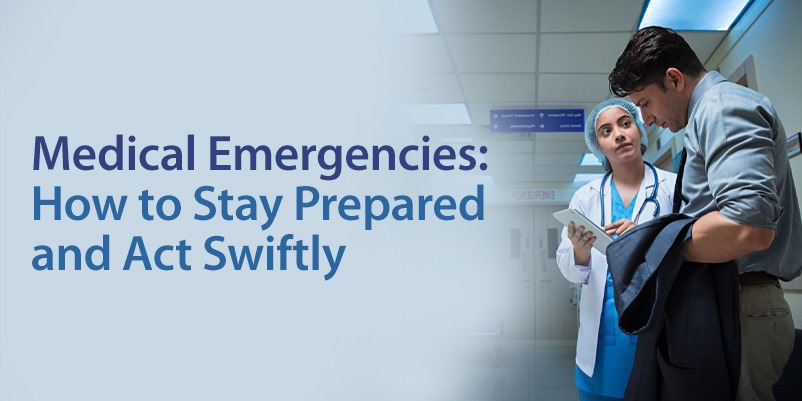Medical emergencies can strike at any time, catching us off guard and testing our ability to respond efficiently. Being ready and understanding how to act quickly can make a significant difference in saving lives, whether it’s an unexpected injury, a heart attack, or a choking event.
- Remain Calm and Evaluate the Situation:
In an emergency, it’s critical to maintain composure and act swiftly to assess the circumstances. Anxiety can impair judgment and make it difficult for you to react appropriately. Inhale deeply, assess the situation, and ascertain the type and urgency of the medical issue.
2. Request Assistance:
In an emergency medical situation, time is critical. Never wait to call for aid if someone is critically hurt or exhibiting symptoms of a medical emergency. To notify skilled specialists who can offer assistance and send required resources to the location, dial 911 or your local emergency number.
3. Give First Aid:
If you are qualified to do so, give first aid while you wait for medical assistance to come. Performing basic first aid techniques, such as performing cardiopulmonary resuscitation (CPR), applying pressure to halt bleeding, or opening an airway blockage, can greatly increase life rates and reduce additional damage.
4. Communicate Clearly:
When calling emergency services, provide clear and concise information about the situation. State your location accurately, describe the nature of the emergency, and follow any instructions given by the dispatcher. Clear communication ensures that responders can assess the situation and provide appropriate assistance promptly.
5. Make Use of the Resources at Your Possession:
If you’re in a public or occupational setting, become familiar with the locations of emergency supplies including first aid kits, AEDs (automated external defibrillators), and emergency exits. In an emergency, knowing where to find and how to use these tools can be very helpful in keeping things under control until aid from a competent source comes.
6. Stay Informed and Prepared:
Educate yourself and your family or colleagues about common medical emergencies and how to respond to them. Take first aid and CPR training courses regularly to refresh your skills and stay updated on best practices for emergency care. Additionally, keep emergency contact numbers handy and maintain a well-stocked first aid kit at home, in your car, and at work.
7. Follow Up:
Once the immediate crisis has been addressed and the individual receives medical attention, follow up with them to offer support and assistance as needed. Depending on the nature of the emergency, they may require ongoing medical care, rehabilitation, or emotional support during their recovery process.
8.Understand the Signs and Symptoms:
Become familiar with the warning signs and symptoms of common medical crises, including diabetic emergencies, allergic responses, strokes, and heart attacks. Early diagnosis of these symptoms can result in more rapid action and better results. If you or someone around has a medical history that might make some emergencies more likely, exercise extra caution.
9. Understand the Signs and Symptoms:
Become familiar with the warning signs and symptoms of common medical crises, including diabetic emergencies, allergic responses, strokes, and heart attacks. Early diagnosis of these symptoms can result in more rapid action and better results. If you or someone around has a medical history that might make some emergencies more likely, exercise extra caution.
10. Take Special Circumstances Into Account:
When handling medical crises, there are several circumstances that may call for special attention. For instance, having survival skills and understanding of wilderness first aid may be quite helpful if you find yourself in a remote or wilderness region. Likewise, if you are providing care for young children or the elderly, educate yourself on paediatric and geriatric emergency care procedures.
11. Maintain Good Hygiene and Infection Control:
Reducing the chance of infection spread during medical emergencies is vital, particularly when there are open wounds or body fluids involved. Before and after administering first aid, wash your hands with soap and water or use hand sanitizer to maintain good hand hygiene. When providing first aid, it is advisable to use personal protective equipment, such as gloves, to safeguard both the patient and yourself from any possible infections.
You may improve the outcomes for those in need of assistance and your capacity to respond to medical emergencies by implementing these extra tips into your emergency preparedness initiatives. Recall that the two most important elements of a successful emergency response are being proactive and remaining informed.




